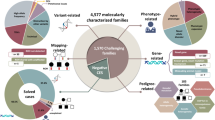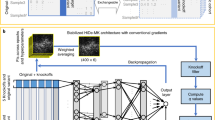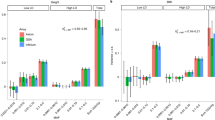Abstract
With the advance of next-generation sequencing technology, the rare variants join the common ones in explaining more proportions of heritability. The coexistence of variants of common with rare, causal with neutral and deleterious with protective is a norm and should be appropriately addressed. Some existing methods suffer from low power when one or more forms of coexistence present, impeding their applications in practice. In this paper, for case–parent trios, pseudocontrols are constructed using the nontransmitted alleles of the parents. The Kullback–Leibler divergence is utilized to measure the difference between the distributions of variants in a genetic region for the affected children and pseudocontrols, and two nonparametric test statistics KLTT and cKLTT are proposed. Extensive simulations show that they are robust to the opposite directions of the causal variants and the amount of neutral variants, and have superiority over the existing methods when both rare and common variants are involved. Furthermore, their efficiency is demonstrated in the application to the data from Framingham Heart Study.
Similar content being viewed by others
Log in or create a free account to read this content
Gain free access to this article, as well as selected content from this journal and more on nature.com
or
References
Hirschhorn, J. N. & Daly, M. J. Genome-wide association studies for common diseases and complex traits. Nat. Rev. Genet. 6, 95–108 (2005).
Eichler, E. E., Flint, J., Gibson, G., Kong, A., Leal, S. M., Moore, J. H. et al. Missing heritability and strategies for finding the underlying causes of complex disease. Nat. Rev. Genet. 11, 446–450 (2010).
Manolio, T. A., Collins, F. S., Cox, N. J., Goldstein, D. B., Hindorff, L. A., Hunter, D. J. et al. Finding the missing heritability of complex diseases. Nature 461, 747–753 (2009).
Bodmer, W. & Bonilla, C. Common and rare variants in multifactorial susceptibility to common diseases. Nat. Genet. 40, 695–701 (2008).
Schork, N. J., Murray, S. S., Frazer, K. A. & Topol, E. J. Common vs. rare allele hypotheses for complex diseases. Curr. Opin. Genet. Dev. 19, 212–219 (2009).
Ahituv, N., Kavaslar, N., Schackwitz, W., Ustaszewska, A., Martin, J., Hébert, S. et al. Medical sequencing at the extremes of human body mass. Am. J. Hum. Genet. 80, 779–791 (2007).
Ji, W., Foo, J. N., O'Roak, B. J., Zhao, H., Larson, M. G., Simon, D. B. et al. Rare independent mutations in renal salt handling genes contribute to blood pressure variation. Nat. Genet. 40, 592–599 (2008).
Iyengar, S. K. & Elston, R. C. The genetic basis of complex traits: rare variants or “common gene, common disease”. Methods Mol. Biol. 376, 71–84 (2006).
Chen, G., Yuan, A., Zhou, Y., Bentley, A. R., Zhou, J., Chen, W. et al. Simultaneous analysis of common and rare variants in complex traits: application to SNPs (SCARVAsnp). Bioinform. Biol. Insights 6, 177–185 (2012).
Lee, S., Wu, M. C. & Lin, X. Optimal tests for rare variant effects in sequencing association studies. Biostatistics 13, 762–775 (2012).
Amos, C. I. Successful design and conduct of genome-wide association studies Hum. Mol. Genet. 16, 220–225 (2007).
Benyamin, B., Visscher, P. M. & McRae, A. F. Family-based genome-wide association studies. Pharmacogenomics 10, 181–190 (2009).
Laird, N. M. & Lange, C. Family-based designs in the age of large-scale gene-association studies. Nat. Rev. Genet. 7, 385–394 (2006).
Wu, M. C., Lee, S., Cai, T., Li, Y., Boehnke, M. & Lin, X. Rare-variant association testing for sequencing data with the sequence kernel association test. Am. J. Hum. Genet. 89, 82–93 (2011).
Pan, W., Kim, J., Zhang, Y., Shen, X. & Wei, P. A powerful and adaptive association test for rare variants. Genetics 197, 1081–1095 (2014).
Spielman, R. S., McGinnis, R. E. & Ewens, W. J. Transmission test for linkage disequilibrium: the insulin gene region and insulin-dependent diabetes mellitus (IDDM). Am. J. Hum. Genet. 52, 506–516 (1993).
Rabinowitz, D. & Laird, N. A unified approach to adjusting association tests for population admixture with arbitrary pedigree structure and arbitrary missing marker information. Hum. Hered. 50, 211–223 (2000).
De, G., Yip, W.-K., Ionita-Laza, I. & Laird, N. Rare variant analysis for family-based design. PLoS ONE 8, e48495 (2013).
Ionita-Laza, I., Lee, S., Makarov, V., Buxbaum, J. D. & Lin, X. Family-based association tests for sequence data, and comparisons with population-based association tests. Eur. J. Hum. Genet. 21, 1158–1162 (2013).
He, Z., O'Roak, B. J., Smith, J. D., Wang, G., Hooker, S., Santos-Cortez, R. L. P. et al. Rare-variant extensions of the transmission disequilibrium test: application to autism exome sequence data. Am. J. Hum. Genet. 94, 33–46 (2014).
Li, B. & Leal, S. M. Methods for detecting associations with rare variants for common diseases: application to analysis of sequence data. Am. J. Hum. Genet. 83, 311–321 (2008).
Auer, P. L., Wang, G. & Leal, S. M. Testing for rare variant associations in the presence of missing data. Genet. Epidemiol. 37, 529–538 (2013).
Madsen, B. E. & Browning, S. R. A groupwise association test for rare mutations using a weighted sum statistic. PLoS Genet. 5, e1000384 (2009).
Pan, W. Asymptotic tests of association with multiple SNPs in linkage disequilibrium. Genet. Epidemiol. 33, 497–507 (2009).
Preston, M. D. & Dudbridge, F. Utilising family-based designs for detecting rare variant disease associations. Ann. Hum. Genet. 78, 129–140 (2014).
Browning, S. R. & Browning, B. L. Rapid and accurate haplotype phasing and missing-data inference for whole-genome association studies by use of localized haplotype clustering. Am. J. Hum. Genet. 81, 1084–1097 (2007).
Zhu, Y. & Xiong, M. Family-based association studies for next-generation sequencing. Am. J. Hum. Genet. 90, 1028–1045 (2012).
Sha, Q. & Zhang, S. A novel test for testing the optimally weighted combination of rare and common variants based on data of parents and affected children. Genet. Epidemiol. 38, 135–143 (2014).
Choi, S., Lee, S., Nöthen, M. M., Lange, C., Park, T. & Won, S. FARVAT: a family-based rare variant association test. Bioinformatics 30, 3197–3205 (2014).
Kullback, S. & Leibler, R. A. On information and sufficiency. Ann. Math. Statist. 22, 79–86 (1951).
Turkmen, A. S., Yan, Z., Hu, Y.-Q. & Lin, S. Kullback-Leibler distance methods for detecting disease association with rare variants from sequencing data. Ann. Hum. Genet. 79, 199–208 (2015).
Davies, R. B. The distribution of a linear combination of chi square random variables. J. Roy. Stat. Soc. C App. 29, 323–333 (1980).
Mailman, M. D., Feolo, M., Jin, Y., Kimura, M., Tryka, K., Bagoutdinov, R. et al. The NCBI dbgap database of genotypes and phenotypes. Nat. Genet. 39, 1181–1186 (2007).
Hsiung, C., Chuang, L.-M. & Hsiao, C.-F. Human SORBS1 genetic variations contribute to insulin resistance, obesity, type 2 diabetes, and hypertension, (13 August 2003) US Patent App. 10/639,491.
Lafferty, A. R., Torpy, D. J., Stowasser, M., Taymans, S. E., Lin, J. P., Huggard, P. et al. A novel genetic locus for low renin hypertension: familial hyperaldosteronism type II maps to chromosome 7 (7p22). J. Med. Genet. 37, 831–835 (2000).
So, A., Duffy, D. L., Gordon, R. D., Jeske, Y. W., Lin-Su, K., New, M. I. et al. Familial hyperaldosteronism type II is linked to the chromosome 7p22 region but also shows predicted heterogeneity. J. Hum. Hypertens. 23, 1477–1484 (2005).
Boomgaarden, I., Vock, C., Klapper, M. & D⊙ring, F. Comparative analyses of disease risk genes belonging to the acyl-CoA synthetase medium-chain (ACSM) family in human liver and cell lines. Biochem. Genet. 47, 739–748 (2009).
Naoharu, I., Katsuya, T., Toshifumi, M., Jitsuo, H., Toshio, O., Koichi, K. et al. Association between SAH, an acyl-CoA synthetase gene, and hypertriglyceridemia, obesity, and hypertension. Circulation 105, 41–47 (2002).
Sharma, K. K., Lindqvist, A., Zhou, X. J., Auchus, R. J., Penning, T. M. & Andersson, S. Deoxycorticosterone inactivation by AKR1C3 in human mineralocorticoid target tissues. Mol. Cell. Endocrinol. 248, 79–86 (2006).
Atsma, F., Veldhuizen, I., de Kort, W., van Kraaij, M., Pasker-de Jong, P. & Deinum, J. Hemoglobin level is positively associated with blood pressure in a large cohort of healthy individuals. Hypertension 60, 936–941 (2012).
Balakumar, P., Kathuria, S., Taneja, G., Kalra, S. & Mahadevan, N. Is targeting eNOS a key mechanistic insight of cardiovascular defensive potentials of statins? J. Mol. Cell Cardiol. 52, 83–92 (2012).
Acknowledgements
We thank two anonymous reviewers for their constructive comments and suggestions that improve the presentation of the manuscript greatly. We thank the FHS participants and acknowledge support from N01-HC25195. This work was supported in part by National Natural Science Foundation of China (11571082, 11171075), National Basic Research Program of China (2012CB316505) and the Scientific Research Foundation of Fudan University.
Author information
Authors and Affiliations
Corresponding author
Ethics declarations
Competing interests
The authors declare no conflict of interest.
Additional information
Supplementary Information accompanies the paper on Journal of Human Genetics website
Supplementary information
Rights and permissions
About this article
Cite this article
Wang, C., Sun, L., Zheng, H. et al. Detecting multiple variants associated with disease based on sequencing data of case–parent trios. J Hum Genet 61, 851–860 (2016). https://doi.org/10.1038/jhg.2016.63
Received:
Revised:
Accepted:
Published:
Issue date:
DOI: https://doi.org/10.1038/jhg.2016.63



